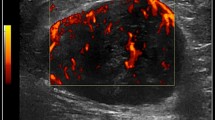Abstract.
Power Doppler sonography (PD) is a technique that displays the strength of the Doppler signal, rather than the flow velocity and directional information. Its increased flow sensitivity and better vascular delineation have been used to document the presence and characteristics of flow in vessels that are poorly imaged with conventional color Doppler (CD), to identify areas of ischemia, to demonstrate inflammatory hyperemia or increased and irregular flow in tumors, as well as to assess serial vascular changes related to interval therapy. The present review reports the general principles of PD, portrays the results of clinical studies available in the literature, and suggests future trends of development.
Similar content being viewed by others
Author information
Authors and Affiliations
Additional information
Received 20 August 1997; Revised 20 February 1998; Accepted 24 February 1998
Rights and permissions
About this article
Cite this article
Martinoli, C., Derchi, L., Rizzatto, G. et al. Power Doppler sonography: general principles, clinical applications, and future prospects. Eur Radiol 8, 1224–1235 (1998). https://doi.org/10.1007/s003300050540
Issue Date:
DOI: https://doi.org/10.1007/s003300050540



